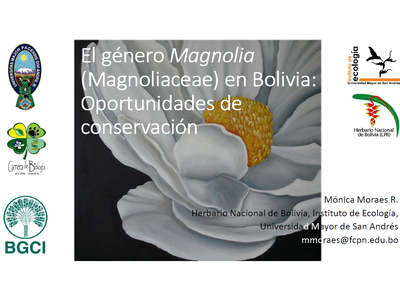The genus Magnolia (Magnoliaceae) in Bolivia: Conservation opportunities
MÓNICA MORAES R.
Herbario Nacional de Bolivia, Unidad Botánica, Instituto de Ecología, Universidad Mayor de San Andrés, c/27 Cota Cota s/n campus universitario, La Paz, Bolivia.
In the Magnoliaceae family, the Magnolia genus has a remarked Holarctic origin and in its wide distribution, Bolivia represents its most extreme expansion south of the continent. So far, 160 species of Magnolia are known in the Neotropics and mean more than a third of the total species worldwide. According to the IUCN categories, a large part is listed under some category of risk: Critically Endangered (CR) with 22%, threatened (EN) with 41% and vulnerable (VU) with 16%; in the Neotropical region, 76% of species are threatened. For this reason, a worldwide deployment has been carried out to attend surveys in the field and to try to maintain the populations of these trees. Together with the IUCN Tree Specialists Group, the National Herbarium of Bolivia has initiated actions to ensure its conservation and propagation. In Bolivia there are only two native species: M. boliviana and M. madidiensis, which are included in the Talauma section; and one introduced species: M. grandiflora that is planted in cities and gardens. Bolivian Magnolia is native to the Amazonian forests of the eastern piedmont of the Andes, from southern Peru to central Bolivia, between 200 and 500 m, is threatened (EN, according to the IUCN) by habitat loss due to extraction of wood and by agricultural expansion. Whereas M. madidiensis ("granadilla", recently described and recognized as endemic to Bolivia), is found in Andean pluvial montane forest with arboreal ferns and also in the Subandino forest of Yungas, between 1,200–2,100 m altitude and has been categorized as threatened. In this case, the species has been included since 2018 in a project with the Botanical Garden Conservation International to carry out actions of seed reproduction and propagation in order to establish ex situ conservation plan. At present, the two biggest difficulties in the field have been the low population density of this species, as well as the fact that no reproductive individuals were found so far. Local residents have commented that it blooms every 2-3 years, but in herbarium material there is evidence that it presented flower buds in May 2010. On the one hand, it is important to consider that M. madidiensis is found in a protected area (Madidi National Park) that may attenuate the threats to which it is subjected, under administration and forest management plans. On the other hand, there are also efforts to regenerate and reproduce new plants under ex situ conservation systems and in botanical gardens, as well as participatory work programs to ensure the maintenance of their populations at the in situ level.

